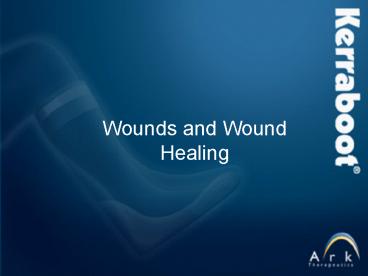Wounds and Wound Healing - PowerPoint PPT Presentation
1 / 18
Title:
Wounds and Wound Healing
Description:
Wound Pathology. Ischaemia. Venous stasis. Oedema. Neuropathic. Infection (systemic) Malignancy ... Following injury, wounds progress through a series of stages. ... – PowerPoint PPT presentation
Number of Views:1393
Avg rating:3.0/5.0
Title: Wounds and Wound Healing
1
Wounds and Wound Healing
2
Kerraboot
Aetiology of Wounds
Trauma Infection Vascular Thermal Chemical Radiati
on
3
Kerraboot
Wound Pathology
Ischaemia Venous stasis Oedema Neuropathic Infecti
on (systemic) Malignancy Connective tissue
disorders Blood dyscrasias
4
Kerraboot
Wound Types
Puncture Surgical Laceration Ulceration Burn Contu
sion (bruise) Avulsion Abrasion
5
Wound Healing
6
Kerraboot
Introduction
Following injury, wounds progress through a
series of stages. Many of these stages may be
occurring in different areas of the wound at the
same time. The stages are Vascular
response Inflammation Proliferation
- Angiogenesis -
Granulation Contraction Epithelialisation
Maturation
7
Kerraboot
Vascular Response
Haemostasis is achieved by clotting at the wound
surface. Platelets contact molecules from
damaged endothelium such as collagen and
fibronectin. The platelets stick to the
endothelium and flatten out in matter of
seconds, increasing their surface area.
The platelets release factors (ADP) to
produce thrombin and cause further platelet
aggregation. The thrombin activates
fibrinogen to fibrin and with tissue factors
from the clotting cascade create irreversible
links between platelets. A platelet/fibrin
plug is formed.
8
Kerraboot
Inflammation
Vasodilation and increased vascular permeability
is initiated by factors and serum proteins from
the clotting and complement cascades. The
platelets release growth factors and chemical
attractants into the wound site. This enables
more cells to move through the endothelium .
9
Kerraboot
Inflammation continued...
Immune cells migrate into the wound through the
endothelium. Neutrophils (leukocytes) engulf
bacteria through phagocytosis and produce
chemotactic molecules and growth factors.
Macrophages phagocytose bacteria and damaged
tissue and produce chemotactic molecules and
growth factors. Lymphocytes produce antibodies
(B cells) and mediate the bodies response to
viruses, fungus and foreign material (T
cells). The growth factors (cytokines) cause
inflammation redness, swelling, heat
and pain.
10
Kerraboot
Proliferation- Angiogenesis and Granulation
- Fibroblasts migrate into the wound and divide in
response to macrophage Platelet Derived Growth
Factor (PDGF). - New extra cellular matrix (ECM) is formed by
fibroblasts. - ECM comprises collagen, elastin, glycoproteins,
proteoglycans and glygosaminoglycans - Collagenase (an Matrix Metaloprotease) is
produced by fibroblasts to remodel ECM - The new ECM forms a scaffold into which
capillaries can grow. The new capillary growth is
stimulated by growth factors (19 known growth
factors) from macrophages, fibroblasts,
neutrophils, mast cells, keratinocytes and
platelets.
11
Kerraboot
Proliferation continued... - Angiogenesis and
Granulation
Blood vessels may be new extensions to existing
vessels. The capillaries form loops in the naïve
tissue which have a red/pink granular appearance
granulation tissue. The granulation tissue
produces increased exudate from the wound
bed. The granulation tissue must form a flat bed
and fill the wound to enable epithelialisation.
12
Kerraboot
Contraction
Specialised fibroblasts (myofibroblasts) draw the
edges of the wound together allowing wound
contraction. Contraction reduces the size of the
wound reducing the potential for infection and
helping to bring damaged tissue together.
13
Kerraboot
Epithelialisation
Epithelial cells (keratinocytes) migrate across
the wound bed from the wound edge. The peri-wound
surface is extremely fragile. The keratinocytes
divide and form layers or strata. Once the
stratified layer is complete, the keratinocytes
undergo a morphological change to become the
epidermis, the normal barrier layer of the
skin. The new tissue continues to be remodelled.
Numbers of fibroblasts fall and capillary bundles
become organised.
14
Kerraboot
Maturation
Remodelling of tissue continues for months or up
to 2 years. Collagen fibres are reorganised to
increase tensile strength. The type of collagen
produce changes ( type III to type I). The scar
initially has about 5 of the tissues pre-injury
strength. The scar may mature to 80 of its
original strength.
15
Kerraboot
Primary Intention Healing
Wounds healing by primary intention have minimal
loss of tissue and apposing edges to the wound.
These wounds occur following injury or an
operation. Edges of the wound are brought
together (approximation) by suturing or
application of adhesive strips. The wound surface
normally forms initial closure within 24 to 48
hours. Primary intention healing can lead to
linear scarring.
16
Kerraboot
Secondary Intention Healing
Wounds healing by secondary intention have some
loss of tissue at the wound site. These wounds
occur following injury or an operation where
tissue is excised. The wound is left open to
allow exudate to drain, removing bacteria and
proteases that slow wound healing. Necrotic
tissue must be debrided. The wound base is
treated to encourage granulation tissue to
provide a base to support re-growth of
epithelium. Skin grafting may be applicable when
granulation tissue has formed.
17
Kerraboot
Tertiary Intention Healing
Wounds healing by tertiary intention have gross
loss of tissue at the wound site. These wounds
occur following injury or an operation where
tissue is excised and foreign material or
infection is present. Necrotic tissue must be
debrided. Often revision surgery to remove dead
tissue is necessary. The wound is kept open to
allow exudate to drain, preventing the spread of
deep infection and aiding granulation.
18
Kerraboot
Tertiary Intention Healing continued...
The wound base is treated to encourage
granulation tissue growth. The edges of the wound
will begin to contract aiding closure. When
foreign material has been removed, necrotic
tissue debrided and infection is no longer
present, the wound edges are brought together to
achieve closure (delayed primary closure).































